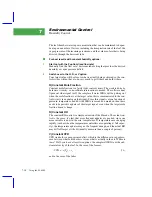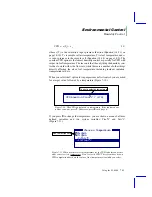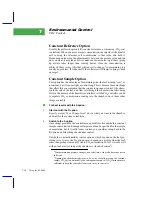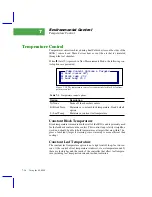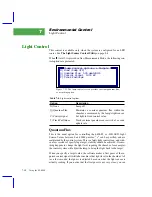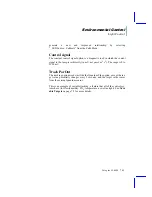
Light Sensor Considerations
8-2
Using the LI-6400
8
Radiation is the most important environmental factor in photosynthesis, and
the most difficult to measure. If you could measure the irradiance on a leaf to
within 5%, youÕd be doing very well. In reality, the measurement error is
more like 10%
1
. But 5% or 10% errors would be intolerable for temperature,
CO
2
concentration, or humidity, since we can measure those parameters to
better than 1%. This chapter explains how the LI-6400 measures photosyn-
thetically active radiation.
Why Two Sensors?
The optional External Quantum Sensor (part # 9901-013) measures photo-
synthetic photon flux density (PPFD) over the 400nm to 700nm waveband. It
gives accurate results with most light sources over a wide range of incident
angles, and is mounted in a position that minimizes errors due to shading. ItÕs
a good quantum sensor, but thereÕs a problem: itÕs in the wrong place.
The external quantum sensor does not have the same field of view as the leaf
element in the chamber, nor is it subject to similar shading conditions, angular
responses, or attenuation by the chamber window. In an extreme case, when
the quantum sensor is shaded and the leaf isnÕt, the quantum sensor could be
measuring a factor of 10 lower than the actual irradiance on the leaf. In more
typical conditions, there will easily be differences of 10%.
To address this problem, the standard light sensor in the LI-6400 is an unfil-
tered gallium arsenide phosphide (GaAsP) device that is small enough to be
placed in the chamber very near the leaf plane. A calibration coefficient
weighted for a Òsun+skyÓ spectrum is provided in the LI-6400 Configuration
list. The spectral properties and calibration of the GaAsP sensor are discussed
below, but in essence, we are getting a second measurement thatÕs very nearly
in the right location, but with a less-than-ideal sensor.
1.
See ÒRadiation MeasurementÓ for a discussion of all the sources of error. This
article is found in the LI-COR brochure, ÒRadiation Measurement InstrumentsÓ,
publication number LM1-11/94.
Содержание LI-6400
Страница 1: ...Using the LI 6400 Portable Photosynthesis System ...
Страница 15: ...Part I The Basics ...
Страница 16: ......
Страница 174: ...Making Measurements Answers to Questions 4 56 Using the LI 6400 4 ...
Страница 175: ...Part II Useful Details ...
Страница 176: ......
Страница 200: ...Standard Tools Power ON Hooks 5 24 Using the LI 6400 5 ...
Страница 214: ...Real Time Data Real Time Graphics 6 14 Using the LI 6400 6 ...
Страница 234: ...Environmental Control Light Control 7 20 Using the LI 6400 7 ...
Страница 244: ...Light Sensor Considerations Gallium Arsenide Phosphide GaAsP Sensor 8 10 Using the LI 6400 8 ...
Страница 288: ...Data Logging Making Your Own AutoPrograms 9 44 Using the LI 6400 9 ...
Страница 289: ...Part III Working With Files ...
Страница 290: ......
Страница 312: ...The LPL File System Troubleshooting 10 22 Using the LI 6400 10 ...
Страница 340: ...Downloading Files Using a Data Capture Program 11 28 Using the LI 6400 11 ...
Страница 375: ...Part IV Configuration Issues ...
Страница 376: ......
Страница 420: ...Defining User Variables Old Style vs New Style 15 18 Using the LI 6400 15 ...
Страница 454: ...Using an Energy Balance Further Reading 17 12 Using the LI 6400 17 ...
Страница 455: ...Part V Maintenance Troubleshooting ...
Страница 456: ......
Страница 572: ...Troubleshooting Useful Information 20 46 Using the LI 6400 20 ...
Страница 587: ...Diagnostics and Utilities Sys Utility Programs Using the LI 6400 21 15 EBVpd t C guess EBSatVap _EBvap_kPa ...
Страница 593: ...Part VI Programming ...
Страница 594: ......
Страница 622: ...Programming with LPL Compiler Directives 22 28 Using the LI 6400 22 ...
Страница 846: ...Index I 16 Using the LI 6400 ...



